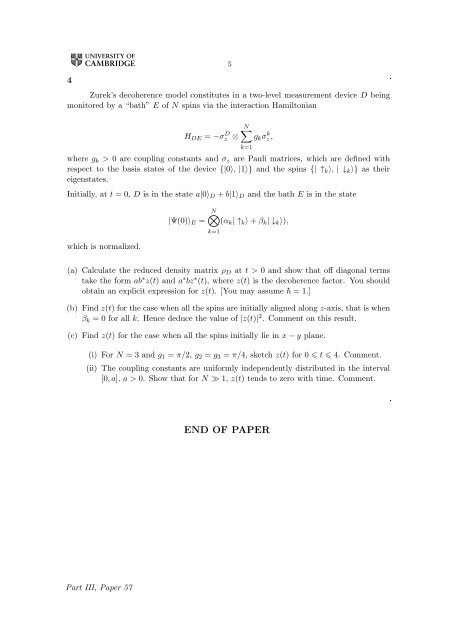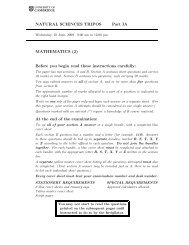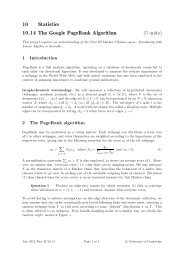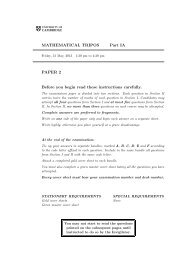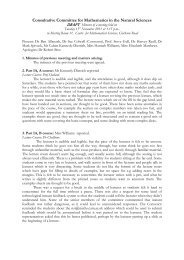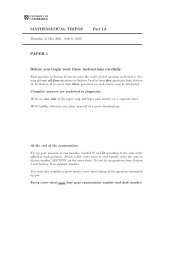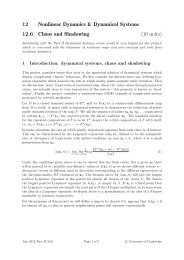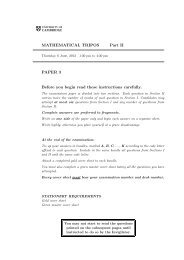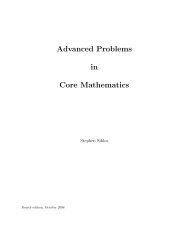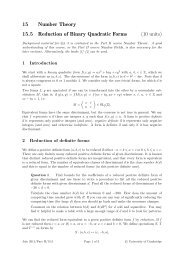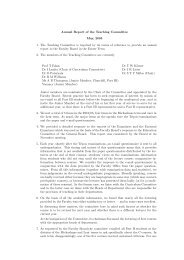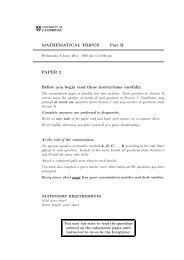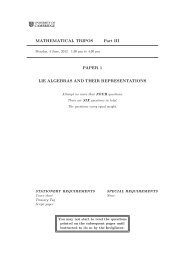MATHEMATICAL TRIPOS Part III PAPER 57 QUANTUM ...
MATHEMATICAL TRIPOS Part III PAPER 57 QUANTUM ...
MATHEMATICAL TRIPOS Part III PAPER 57 QUANTUM ...
Create successful ePaper yourself
Turn your PDF publications into a flip-book with our unique Google optimized e-Paper software.
5<br />
4<br />
Zurek’s decoherence model constitutes in a two-level measurement device D being<br />
monitored by a “bath” E of N spins via the interaction Hamiltonian<br />
H DE = −σ D z ⊗<br />
N∑<br />
g k σz,<br />
k<br />
where g k > 0 are coupling constants and σ z are Pauli matrices, which are defined with<br />
respect to the basis states of the device {|0〉, |1〉} and the spins {| ↑ k 〉, | ↓ k 〉} as their<br />
eigenstates.<br />
Initially, at t = 0, D is in the state a|0〉 D +b|1〉 D and the bath E is in the state<br />
which is normalized.<br />
|Ψ(0)〉 E =<br />
k=1<br />
N⊗<br />
(α k | ↑ k 〉+β k | ↓ k 〉),<br />
k=1<br />
(a) Calculate the reduced density matrix ρ D at t > 0 and show that off diagonal terms<br />
take the form ab ∗ z(t) and a ∗ bz ∗ (t), where z(t) is the decoherence factor. You should<br />
obtain an explicit expression for z(t). [You may assume = 1.]<br />
(b) Find z(t) for the case when all the spins are initially aligned along z-axis, that is when<br />
β k = 0 for all k. Hence deduce the value of |z(t)| 2 . Comment on this result.<br />
(c) Find z(t) for the case when all the spins initially lie in x−y plane.<br />
(i) For N = 3 and g 1 = π/2, g 2 = g 3 = π/4, sketch z(t) for 0 t 4. Comment.<br />
(ii) The coupling constants are uniformly independently distributed in the interval<br />
[0,a], a > 0. Show that for N ≫ 1, z(t) tends to zero with time. Comment.<br />
END OF <strong>PAPER</strong><br />
<strong>Part</strong> <strong>III</strong>, Paper <strong>57</strong>


